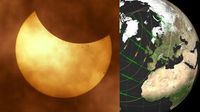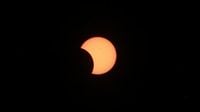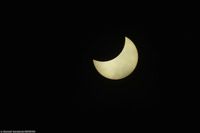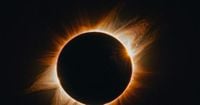On March 29, 2025, a solar eclipse will be visible across Poland, providing a rare opportunity for citizens to witness this celestial event. The eclipse will begin around 11:00 AM local time and reach its peak at approximately 12:28 PM, when the Moon will obscure a significant portion of the Sun.
According to astronomers, the eclipse will manifest as a partial eclipse in Poland, with the Moon covering between 12% and 26% of the solar disk, depending on the observer's location. Szczecin, located in the northwest, will experience the most coverage at about 16%, while Białystok in the northeast will see the least at approximately 6.88%.
Dr. Arkadiusz Berlicki, a professor at the University of Wrocław, explained that a solar eclipse occurs when the Moon passes between the Earth and the Sun, casting its shadow on our planet. He noted, “During this phenomenon, the shadow or penumbra falls on the surface of the Earth, resulting in a total solar eclipse for observers in the shadow of the Moon, or a partial eclipse for those in the penumbra.”
The last total solar eclipse visible in Poland occurred in 1954, and the next one will not happen until 2135. In total, 16 total eclipses have been visible from Poland since 1140, according to the Polish Astronomical Society (PTA). The next partial solar eclipse will occur on August 2, 2027, with a total eclipse visible in parts of North Africa, including over the Egyptian pyramids.
As the eclipse approaches, the Polish Power Grid Operator (PSE) has announced that the event will impact the performance of photovoltaic systems across the country. With an installed capacity of 21.6 GW, the solar energy sector is expected to adjust operations to account for the temporary reduction in sunlight. The PSE stated that it is coordinating with European transmission system operators to manage the energy grid effectively during the eclipse.
“The eclipse will influence the generation levels of photovoltaic sources, and we are considering this event in our analyses and operational plans,” the PSE noted, emphasizing the importance of market participants to account for the eclipse in their trading portfolios.
For those eager to observe the eclipse, the PTA has advised that while the Moon will obscure a small fraction of the Sun, the reduction in brightness may be hardly noticeable to the average observer. “Only those who are aware of the eclipse and use proper solar viewing glasses will be able to see the partially obscured solar disk around noon,” Dr. Berlicki added, highlighting the importance of safety when viewing such events.
As excitement builds for the eclipse, local weather conditions will play a significant role in visibility. According to meteorological forecasts, regions such as Suwałki, Mazury, Mazowsze, Lublin, eastern Pomerania, and Kujawy are expected to have the best weather for viewing, with lower cloud cover. However, in areas like western Pomerania, Greater Poland, and Lower Silesia, cloud cover may hinder visibility, and rain is also a possibility.
“The southern parts of Poland, including Upper and Lower Silesia, Małopolska, and Podkarpacie, will face the most challenges due to cloud cover and potential rain,” said Grażyna Dąbrowska, a meteorologist from the Polish Institute of Meteorology and Water Management (IMGW). Nonetheless, she noted that there may still be opportunities for clear skies, allowing observers in those regions a chance to witness the eclipse.
For those interested in the science behind eclipses, it's essential to understand the different types. A solar eclipse can be partial, total, or annular. In a partial eclipse, only a portion of the Sun is obscured by the Moon. A total eclipse occurs when the Moon completely covers the Sun, while an annular eclipse happens when the Moon is too far from the Earth to block the Sun entirely, resulting in a ring-like appearance.
In the 21st century, Poland will see a total of 40 solar eclipses, mostly partial. Among them, two annular eclipses will be observable over the southern part of the country on July 13, 2075, and July 23, 2093.
As the date approaches, enthusiasts and casual observers alike are encouraged to prepare for the event by ensuring they have the proper solar viewing equipment. Certified eclipse glasses that meet ISO 12312-2 standards are essential for safe viewing. Regular sunglasses do not provide adequate protection. Other safe viewing methods include projecting the Sun's image through a telescope onto a piece of paper or using solar filters designed for telescopes.
With the anticipation of this solar spectacle, the March 29 eclipse promises to be a memorable event for many across Poland. Whether the skies are clear or cloudy, the excitement surrounding this astronomical occurrence is sure to inspire curiosity and wonder among those who take the time to look up.









